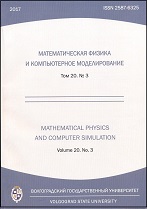|
This article is cited in 7 scientific papers (total in 7 papers)
Modeling, informatics and management
Numerical modeling of self-consistent dynamics of shallow and ground waters
S. S. Khrapov
Volgograd State University
Abstract:
A mathematical and numerical model of the joint dynamics of shallow and ground waters has been built, which takes into account the nonlinear dynamics of a liquid, water absorption from the surface into the ground, filtration currents in the ground, and water seepage from the ground back to the surface.
The dynamics of shallow waters is described by the Saint-Venant equations, taking into account the spatially inhomogeneous distributions of the terrain, the coefficients of bottom friction and infiltration, as well as non-stationary sources and flows of water.
For the numerical integration of Saint-Venant's equations, the well-tested CSPH-TVD method of the second order of accuracy is used, the parallel CUDA algorithm of which is implemented as a software package “EcoGIS-Simulation” for high-performance computing on supercomputers with graphic coprocessors (GPU).
The dynamics of groundwater is described by the nonlinear Bussensk equation, generalized to the case of a spatially inhomogeneous distribution of the parameters of the porous medium and the surface of the aquiclude (the boundary between water-permeable and low-permeable soils).
The numerical solution of this equation is built on the basis of a finite-difference scheme of the second order of accuracy, the CUDA algorithm of which is integrated into the calculation module of the “EcoGIS-Simulation” software package and is consistent with the main stages of the CSPH-TVD method.
The relative deviation of the numerical solution from the exact solution of the nonlinear Boussinesk equation does not exceed $10^{-4}$–$10^{-5}$.
The paper compares the results of numerical modeling of the dynamics of groundwater with analytical solutions of the linearized Bussensk equation used as calculation formulas in the methods for predicting the level of groundwater in the vicinity of water bodies.
It is shown that the error of these methods is several percent even for the simplest case of a plane-parallel flow of groundwater with a constant backwater.
Based on the results obtained, it was concluded that the proposed method for numerical modeling of the joint dynamics of surface and ground waters can be more versatile and efficient (it has significantly better accuracy and productivity) in comparison with the existing methods for calculating flooding zones, especially for hydrodynamic flows with complex geometry and nonlinear interaction of counter fluid flows arising during seasonal floods during flooding of vast land areas.
Keywords:
hydrodynamics of surface and ground waters, shallow water model, porous media, ltration ows, numerical modeling, CSPH-TVD method, parallel computing, CUDA algorithm, supercomputers with GPU.
Received: 30.05.2021
Citation:
S. S. Khrapov, “Numerical modeling of self-consistent dynamics of shallow and ground waters”, Mathematical Physics and Computer Simulation, 24:3 (2021), 45–62
Linking options:
https://www.mathnet.ru/eng/vvgum313 https://www.mathnet.ru/eng/vvgum/v24/i3/p45
|

|




 Contact us:
Contact us: Terms of Use
Terms of Use
 Registration to the website
Registration to the website Logotypes
Logotypes








 Citation in format
Citation in format 
